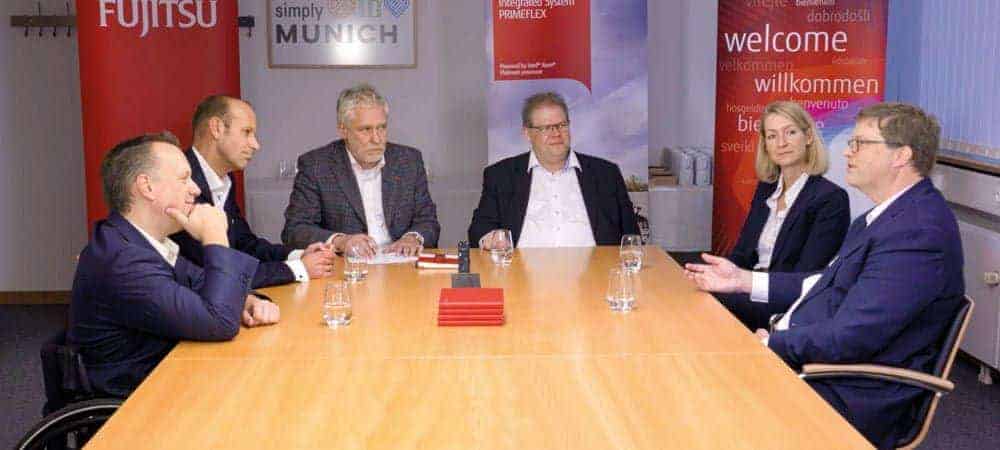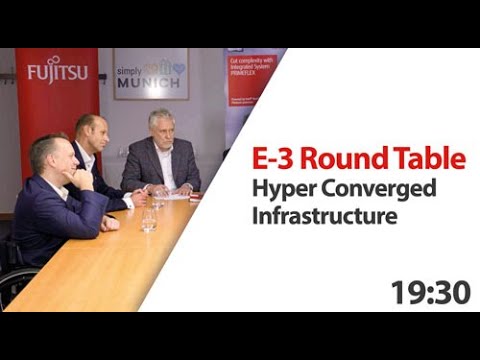Basis of the S/4 Hana transformation


The transformation to Hana and S/4 is more than just a technical release change, but the IT architecture and infrastructure should also be an essential part of the roadmap.
The decision between cloud and on-prem is not a trivial one, because on-prem as a hyperconverged infrastructure can also mean the cloud in your own data center.
The opportunities and challenges of an S/4 Hana roadmap were discussed by Bas Raayman, Principal Architect at Nutanix, Peter Goldbrunner, Country Manager Central Europe at Nutanix, Peter Färbinger, moderator and editor-in-chief of E-3 Magazin, Wolfgang Schwab, Principal Consultant/Analyst at Teknowlogy, Meike Thoebel, Senior Sales Manager at Fujitsu, and Michael Straub, SAP Proposition Manager EMEIA at Fujitsu.
Nutanix has focused on the SAP community, among others, and supports users on their way to Hana and S/4. In addition to fundamental considerations such as a brownfield or greenfield transformation, the questions of optimal data storage and an adequate infrastructure must also be resolved. The cloud model offers advantages, but there are numerous cloud implementations including hyperconverged infrastructure.

Many existing SAP customers have a long data center history. Numerous technologies have been used over the years. The IT infrastructure has always been a key component of success.

Typically, the infrastructure consists of a compute part, where I have various server systems, then I have a storage part in a rack and, of course, the network somewhere. In some data centers, these components are supplemented with a virtualization layer - i.e. compute, storage, network and a virtualization layer on top.
If I integrate all these components in a separate software layer that is based on x86-capable metal hardware, then I have a hyperconverged infrastructure or HCI solution.

Bas Raayman, Nutanix: I abstract even further. What characterizes hyperconverged infrastructure is the reduction of components that I have to manage - in other words, a reduction of operational complexity, reduction of risks, for example of misconfigurations, etc.
The combination, the convergence, is already included in the definition. It also means simplifying administration. Hyperconverged infrastructure is an industrialization of the data center.
Individual tasks that were previously assembled separately are industrialized and delivered as a single concept. The whole thing is highly automated and reduces complexity and, at the end of the day, probably also costs.

Färbinger: Fujitsu has a successful history from the mainframe to cloud computing. Is hyperconverged infrastructure a threat? Or is it an option?

It's not a threat in any way. If I focus on SAP applications, then hyperscalers, infrastructure as a service and cloud computing are an option and hyperconverged infrastructure is another interesting way of operating state-of-the-art on-prem installations.
HCI is also very important for Fujitsu because many of our customers are migrating the SAP ERP core. Many ERP/ECC users are switching to the S/4 Hana world and are naturally interested in mapping this transformation in their on-premises systems. Our customers benefit from the partnership with Nutanix.
I also see other options such as SaaS, Software as a Service. An S/4 Hana migration will not only be successful on-prem. There are also HR issues with SuccessFactors or Ariba. Challenges such as multicloud and hybrid worlds are obvious.

How do you see these scenarios in the SAP ERP market?

Agility is an important aspect that also drives us in the S/4 Hana context. After all, simple scalability is an additional added value that customers want to use in this context.

The topic of "Hana" should also be assessed from a database perspective. This system is made to grow - not to become smaller. How can I continue to scale sensibly? Simply adding terabytes will not be the solution in the end.

How can I decide what I need to keep and what I can safely dispose of? And that is ultimately the big challenge with all databases and system migrations.
Whether it's SAP or other ERP systems. Keeping all data is easy - and can theoretically be done at any cost. But at some point, the systems no longer perform. What can I get rid of is a crucial data question.

It is recognized that databases need to be normalized. We also need to deduplicate data so that the systems remain efficient and the amount of data remains manageable.
Approaches such as in-memory databases have completely thrown this concept overboard. Because I want to keep all the data in different forms so that I can run analyses.

It's basically the basic idea of big data. I can not only look at normalized databases, but basically anything that wants to come along. Ultimately, that's the challenge. Am I interested in the weather report from two weeks ago? Probably not anymore.
But deciding that I can delete it is dangerous. It could be that I might need it after all to train an artificial intelligence in the next step. So it's difficult, but at the end of the day you have to make the decision: What can I ultimately afford in business terms?

Hana has not stabilized as quickly as Professor Hasso Plattner might have wished. Operating Hana is a huge challenge. If I put Hana in a cloud, I have also delegated problems. Do I want on-prem, including the responsibility for administration, or do I put Hana in the cloud?

The issue of responsibility must be seen separately from the issue of availability. I still have to master the complexity, even if I go in the direction of a public cloud provider.
The system wants to be updated in any case - but someone else is responsible for it. But the outsourced responsibility doesn't help me if I can't work in the meantime.
If I don't have my own expertise, this can have a lasting impact on my business. This situation is independent of whether I am in a public cloud or whether I am running SAP in my private cloud.

A service provider that provides managed services has exactly the same options, regardless of whether it is on an HCI or in a hyperscaler world. We have experience with both concepts.

Regardless of the operator model, the dynamics in an SAP environment have increased. That's why I understand this as the customer's wish to go to a Fujitsu or perhaps to a hyperscaler with service issues, because the effort or the dynamics bring complexity and generate expenses.
This is where a new infrastructure that can cope with this dynamic helps. Dynamism drives the need for adaptation and HCI is one of the options for controlling this agility or tapping into it.

Becoming more agile is a must, as there is more and more data that needs to be processed or analyzed at a certain speed. This is where Hana as a database has a key role to play. To come back to the application level: Here it must be taken into account that S/4 is a hybrid model where parts must also be outsourced to the cloud.

Is this hybrid business model an option for the future that I can use to dry up my digital transformation? Or is it a stopgap solution?

It is a stopgap solution with a promising future. What is emerging is actually a hybrid multicloud model. You have legacy applications that you will no longer touch because it is ultimately far too expensive. You use private cloud and of course you use hyperscalers.
What everyone would ultimately like to have is a management level above that ensures that I can manage everything homogeneously so that I can move workloads back and forth, for example. And as a very long-term strategy, everything should of course move towards hyperscalers. Theoretically! In practice, it's simply unthinkable for many workloads.

More theoretical or more practical?

You can make applications cloud-enabled, i.e. native cloud-enabled - if you have a lot of money and a lot of time. If you take a very strategic approach to the transformation, you can consider it.
Most do not. And with lift and shift you achieve few advantages, but also incur few costs. But it's not strategic. Hence this hybrid approach, which is set for the next five to ten years. And what comes after that, nobody probably knows at the moment.

You say that the cloud is the ultimate approach. Isn't it more about the idea of what the cloud offers - i.e. the consumption option model? I'm familiar with these cloud services and if you can also take this approach in your own data center, then I don't necessarily have to choose an external cloud provider.

Cloud is an operating model. Whether this is a private cloud or a public cloud may not be so decisive in the initial approach. And if I can also guarantee agility on-prem, then there is nothing to stop me from continuing to pursue the cloud operating model in-house.

Many users move towards the public cloud and then realize at some point that it's not necessarily as cheap as they thought. If I have to move data back, for example, the costs are completely different.
The concept of "If I don't use the cloud, I don't pay for it" is also rarely practiced to its full extent. Of course, I have the advantages of handing over some of the responsibility to a service provider.

Customers need more and more flexibility - whether with hyperscalers or a service from us. Costs are a decisive factor and we are naturally feeling the pressure from the market.
One answer to this is the topic of Hyper Converged Infrastructure. In general, I agree with the thesis that hybrid IT is not only the preferred model today, but will also be the preferred model in the coming years.
Nutanix technologies will also lead to a "renaissance" of on-prem installations. Our customers are very open to this development and welcome the fact that we also offer such technologies for on-prem use.
At the same time, we also need to show how we can integrate hyperscaler offerings or how test systems can be implemented cost-effectively. Other aspects include the efficient integration of disaster recovery systems - which we hope will never be needed - and ensuring a high level of flexibility overall.

Fujitsu is probably one of the best examples of hybrid worlds - a service provider on the one hand and a renowned IT manufacturer on the other.
They have mainframe roots. And this is a good example of how it is always the case in IT that new models have their justification, but do not automatically replace older models. The IT world is hybrid and it will remain hybrid for a long time.

If you look at the issue of latency times in production control, pure cloud systems can pose challenges. So perhaps your own data center with a hyperconverged infrastructure from Nutanix is superior?

What happens if the service provider for this dedicated line to the cloud fails? That's why I don't believe that this cloud decentralization will be the solution for all companies. Hybrid will be an issue in the telco service desert that is Germany.
That may be different in Nordic countries with fiber-to-home etc.. I see a certain area of tension in Germany and we can definitely offer solutions with the private cloud approach.

If there is only one telecom connection for mission-critical systems, this should of course generally be rejected. And on the other hand, there is physics. If the data center is located in Frankfurt and you are somewhere else, then there is simply a certain latency.
If you use it to control your production, five parts will fall until the response comes from the server. Regardless of how wide the line is. It's pure physics. How fast is the light?

In addition to the technical dimensions, however, there is a fundamental decision that the customer himself makes from a business perspective. Do I want this? Do I expect an advantage?
The motivation is different. And drives this hybrid model. The biggest advantage is that I can decide for myself where I want to go without technology necessarily telling me what to do.

SAP Co-CEO Christian Klein said in an E-3 interview that SAP will increasingly focus on on-prem in the future. He even literally said that structural or political conditions in certain countries make it necessary to have your own data center.

This is also consistent with our experience. Many of our customers who are thinking about cloud services tend to think of it as Platform as a Service and Software as a Service. In discussions with our customers, we also frequently receive questions about the possible uses of SuccessFactors, Ariba, Concur or Qualtrix. In general, however, the focus is primarily on SAP's cloud offerings when switching to S/4 Hana.

Of course, the entire SAP community has its sights set on 2025 and in this context we are converting ECC licenses to S/4 Hana licenses. In this context, it is indeed the case that some functions from ECC with S/4 Hana will ultimately no longer be available at all or only to a lesser extent or will have to be obtained from the cloud.

For many years, SAP told us cloud first, cloud first, cloud first. For certain reasons, I can't do everything from the public cloud. But the date 2025 is approaching. What will happen to me now if I can't necessarily migrate to the cloud? I think some customers have felt a bit abandoned.

Is the path to the cloud even recommended? Does SAP have a cloud exit strategy?

All cloud providers have a strategy. It is very easy to go into the cloud. Migrating out of it involves different costs and efforts. Accordingly, I can only recommend that before embarking on the journey to the public cloud, you consider what will happen if it is not a success.

The decisive factor is ultimately the amount of data. Migrating a container with applications from A to B is standard without much effort. It's a matter of five minutes and the job is done.
If there's a terabyte of data attached to it, then it can take a while. Because then you have to work out with the provider at the very beginning how thick the cable is that my data is attached to when I want to get it out. Not for business - the capacities are almost always sufficient.
But the moment I decide to end the contract. At what speed will I then get my data? And if you then realize that you need six months to do this, then you have a problem.

If we try to keep an eye on everything - the business, the organizational, the technical and the licensing - we end up with what a DSAG survey shows many existing SAP customers feel in their gut - we stay on-prem?

I think that's what it will come down to. If we look at what is happening in the market, then the DSAG survey is probably right. We also conduct corresponding studies.
At the moment, we see around ten percent of existing SAP customers moving to S/4 Hana - with one system. Not completely. 50 percent are planning.
These customers have not yet started, but they are planning in this direction. And 40 percent are still thinking about what to do in general. What will I do with my licenses when they are in the cloud? These are considerations where SAP may no longer be the right partner.
And we don't know how that will turn out, we simply have to wait and see. And whether 2025 will be a tough attack? It's relative. It's not as if someone will pull a plug in 2025 and the systems will no longer work.

With the on-prem approach, SAP Co-CEO Christian Klein was presumably merely reflecting the situation on the market. He was of course supposed to align SAP with the interests of customers and at the same time bring this together with his own corporate vision. From this perspective, it is a correct reflection, a reflection of the situation. Not all customers will go to the cloud.

There is still a great deal of uncertainty among customers. There is also uncertainty as to whether they will be able to map all the business processes they have today - including all modifications and Z programs - in the new world.
And ultimately, migration is also a major investment - despite the crediting models that are available. But it is also a great opportunity for companies!
It is also important to involve the entire workforce. The employees need to be trained. They have been working with their previous systems for years and now have to adapt to completely new workflows and processes.
In my opinion, this aspect is always neglected in the discussion. And in my discussions with customers, I always point out that it's not just about a new infrastructure, but that such a migration is equivalent to a new ERP implementation, which is ultimately also a great opportunity.

We are here at Fujitsu Forum 2019 and compared to previous years we have a record number of S/4 related Expert Talks this year. In previous years, there was nowhere near as much interest.
I agree with Mr. Schwab's assessment that we can expect a much higher number of S/4 Hana transformation projects from 2020.

We have had similar experiences at Nutanix. I was present at some of the Expert Talks. You can increasingly see the demand.

Because the date 2025, if we stick with it, is getting closer and closer.

And you don't complete these projects in three months. Especially with the Z transactions, my customizing, I have to think about adapting them or I have to change the way I work. The number of consultants is limited. I believe that this definitely requires education from the partner.

Definitely. But the fear of the ever-closer date of 2025 must not be the sole driving force.

If you look at the project costs for corresponding migrations, then there must be more to it than just changing the system. If the technical release change is the only thing, then we don't need to start.

In all this uncertainty, what advice could you give a traditional SAP customer on how to design their architecture and infrastructure?

Design the infrastructure as flexibly as possible so that a change, whenever it takes place, is not limited or unnecessarily complicated by infrastructure.
And while the existing SAP customer plans to ensure that its own operating concept, whether it does it itself or perhaps commissions Fujitsu to do it, is built in such an agile way that it ideally experiences the benefits that it may get in the cloud itself in the data center.

It's important to look at the business requirements. If I have to migrate technically in the meantime because my hardware has somehow expired, I can still extend my service contracts until my strategy has crystallized further.
Therefore, my initial recommendation would be: existing SAP customers, analyze what you want to achieve with your business. And plan your strategy accordingly.

We offer Discovery Workshops in which we spend two days on site at the customer's premises analyzing the current situation - from an application perspective. The key question here is: What could a roadmap towards S/4 Hana look like?
In a second step, the corresponding infrastructure assessments are carried out and we discuss the issues surrounding the licenses.

Of course, we also offer special workshops in which we take a detailed and granular look at the customer's license portfolio and create a mapping on this basis and suggest or carry out optimizations.

The analyst has the last word. A large part of the SAP community is still observing and pondering?

It is still being observed. Where relatively many users are sure that it should be on-prem. Which is quite astonishing. And that it should take place in-house.
If you wait another twelve or 18 months and maintain the status quo until then, you will eventually reach a point where you realize that you have to act now. But I can't act because by the time I think about the infrastructure and possibly licenses etc., time will have run out or expired.
Then there are two options: either I find another service provider who somehow has time, or I actually go for the greenfield approach - which is what a third of users actually want to do. Depending on how late you are, customizing then looks rather bad. That's why I adapt my company to the software.
We are used to this in SaaS environments. So perhaps that's not such a bad thing. Strategically, it makes sense to think about the infrastructure now. What it needs to look like in general, almost detached from SAP.
Because you generally have these questions. I have old systems that I want to continue operating. I have newer systems that I may want to keep on-prem, but later in a cloud environment. And I can build up the flexibility and the corresponding management layer today.
Nobody will take them away from me if I say I would like to have Hana now. Ultimately, this is a sensible approach. Today, I have to solve the infrastructure issue or infrastructure management.
Strategically, where do I actually want to go? And I have the SAP topic now, or perhaps a little later, but not much later. But waiting is not really an option.

Thank you for the interview.







